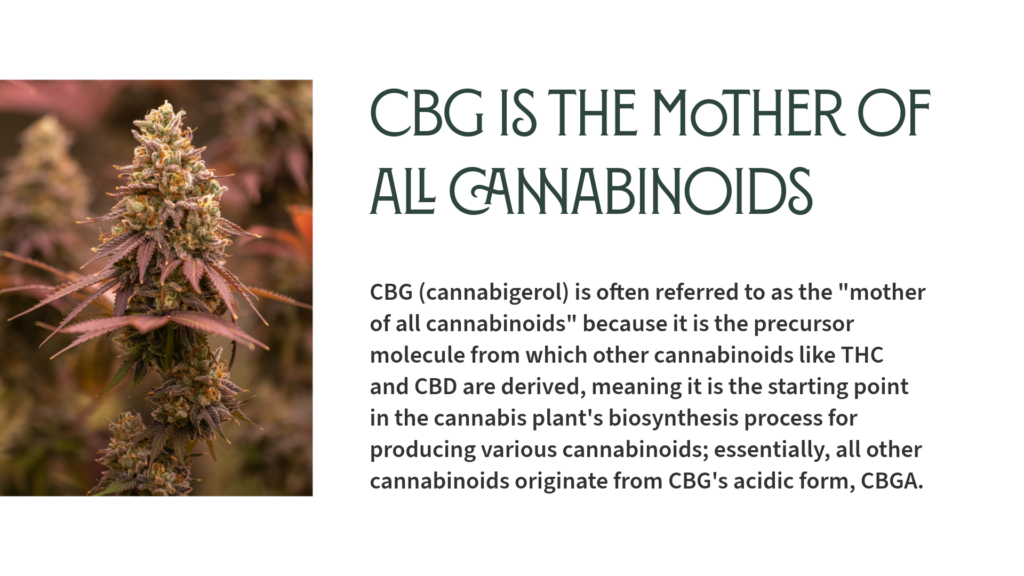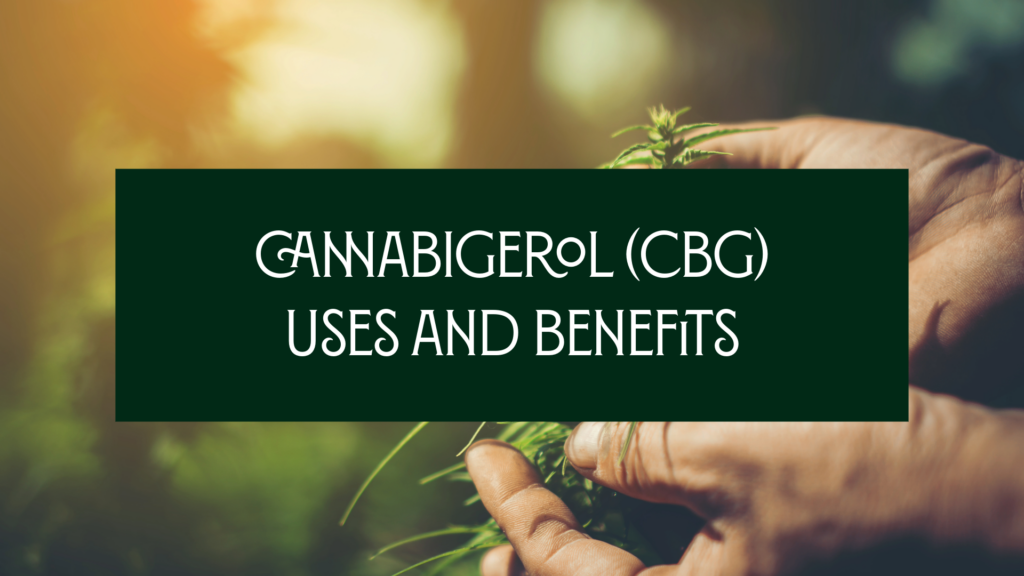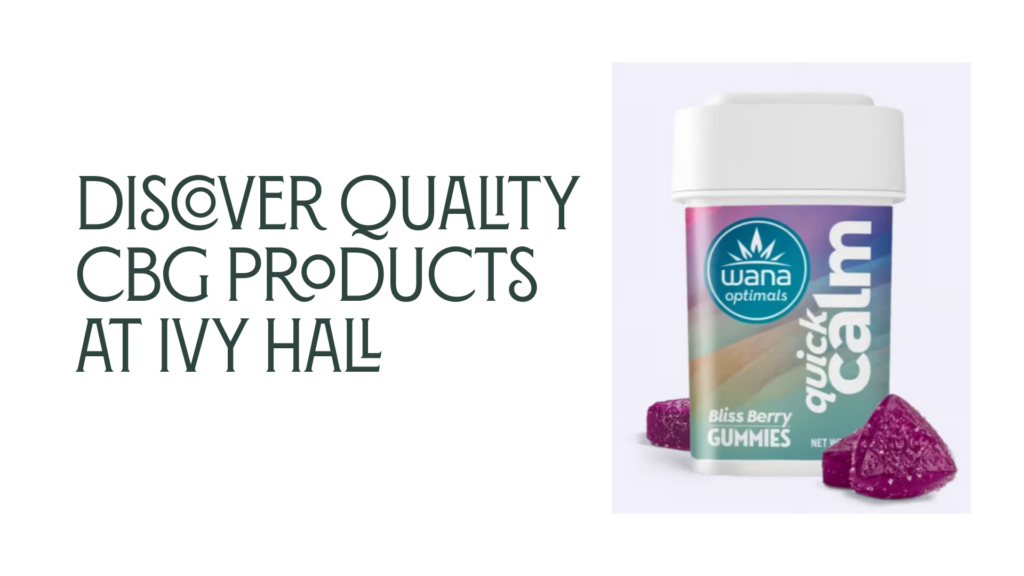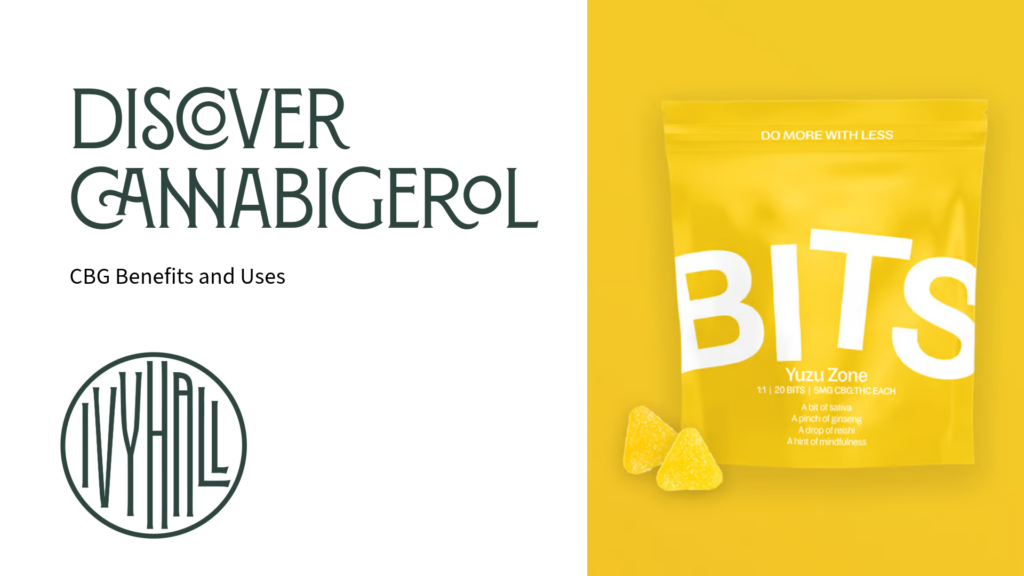Cannabigerol (CBG), a lesser-known cannabinoid compound found in the cannabis plant, has emerged as a compound with budding prospects for promising health benefits. As discussion grows regarding the various therapeutic and healing advantages of consuming cannabis products, cannabinoid proponents and researchers alike have started to look into the yet-to-be-discovered health rewards of the many cannabis compounds. CBG, along with its less obscure counterparts, CBD and THC, appears to provide some exciting advantages for cannabis enthusiasts.
Ivy Hall is committed to providing you with the information you need to make the best decision regarding the cannabinoids you prioritize. Learn more about the basics behind cannabigerol (CBG) and what it can do for your mental and physical well-being.
What Is Cannabigerol (CBG)?
Cannabis has been used for centuries in Eastern medicine, and it is cultivated worldwide. The active components of the cannabis plant have been found to possess therapeutic and pharmacological properties. The increased interest has provided the space to explore its latent properties further for medicinal use as well as recreational consumption.
The benefits of cannabis are primarily achieved by its cannabinoids, active chemical compounds that can interact with the human endocannabinoid system, a cannabinoid-specific communications pathway that plays a critical role in many of our bodily functions. Cannabinoids are present in many plants and even produced by the human body, but the best-known are present in the cannabis plant. The best-researched and most frequently used are cannabidiol (CBD) and delta-9-tetrahydrocannabinol (THC). CBG, though found in lesser quantities in the cannabis plant than its counterparts, is a cannabinoid compound that may have healing properties like CBD and THC.
Exploring popular cannabinoids, like CBG, can help empower you to find the right products that meet your health needs.
CBG Is the Mother of All Cannabinoids

CBG is known in the scientific community as the mother of all cannabinoids. This is because it is produced from remnants of cannabigerol acid (CBGA), a cannabinoid acid, following decarboxylation. Most CBGA within the cannabis plant is transformed into CBG and the other commonly known cannabinoids, including THC and CBD, through biosynthesis. Thus, CBGA is a precursor of CBG, CBD, and THC.
Since CBGA is a precursor, it is depleted as it is converted into other cannabinoids. Likewise, CBG levels decrease as a cannabis plant ages.
Differences Between CBG, CBD, and THC in the Cannabis Plant
Despite CBG’s relationship to the development of CBD and THC in the cannabis plant, these three active compounds differ in a few ways:
Psychoactive Properties
THC is well-known as a psychoactive compound, meaning it produces a high when consumed. However, this euphoric feeling is not produced when one consumes CBG and CBD, as these two compounds do not have the same effects on the endocannabinoid system.
Limited Levels
The percentage of CBG found in the cannabis plant cultivated for medicinal and recreational THC use is relatively low compared to THC. In industrial hemp plants cultivated with very little THC (as indicated by US federal law), CBG is found at a slightly higher percentage than THC, but much lower than CBD. As mentioned, as the plant ages, CBG levels will continue to diminish.
Limited Research
Though there is a growing interest in the effects of CBG in our endocannabinoid system, research is limited. A large portion of existing research focuses on THC and, to a lesser extent, on CBD. For this reason, there is still a lot to learn about CBG’s potential, though there have been studies that have shed light on its promising effects.
Legal Aspects
Cannabis is also a controlled substance on a federal level when it contains THC levels above 0.3%. In some states, its consumption is thus limited to medical use. CBD and CBG can be consumed with much less regulation as long as products are derived from cannabis containing less than 0.3% THC. Here in Illinois, however, all three cannabinoids are available for medicinal and recreational consumption.
CBG and its cannabinoid siblings have a lot in common, but they each stand out on their own. The rising interest in cannabigerol (CBG) has allowed us to dig deeper into how CBG affects our body and how combining CBG and CBD may result in added advantages. Let’s explore the other major differences between CBG and its cannabinoid counterparts: their various therapeutic effects.
Cannabigerol (CBG) Uses and Benefits

Emerging scientific research continues to highlight the numerous cannabigerol (CBG) uses and benefits previously unknown to us. Though there is still a lot more to discover about this once-obscure cannabinoid, the cannabis community is excited about the potential value there is to gain from consuming and using CBG products.
Cannabinoids and Our Endocannabinoid System
The endocannabinoid system plays a role in regulating various functions in the body. It does so through endogenous cannabinoids produced within the body, naturally binding with cannabinoid receptors and being synthesized by enzymes. The main cannabinoid receptors are CB1 and CB2 cannabinoid receptors. CB1 receptors are found abundantly in the brain, while numerous CB2 receptors carry out a prominent role in the immune system.
Toxins, stress, infections, or illnesses can wreak havoc on the body, hampering regular bodily functions. Since cannabinoids found in cannabis have been shown to mimic endocannabinoids produced by the body, researchers have studied their role in treating symptoms of various conditions.
CBG’s Potential Anti-inflammatory Properties
CBG’s anti-inflammatory properties highlight its similarities with other commonly used cannabinoids as a potential treatment option. Though research is limited, case studies have found that CBG can be used to alleviate symptoms of autoimmune disorders like rheumatoid arthritis, which is an inflammatory disease. There is also an interest in the potential therapeutic benefits of CBG for the treatment of multiple sclerosis through its effect on the microglia cells of the brain.
How CBG May Help Support Gastrointestinal Health
Those suffering from digestive health problems may be aware of the link between gastrointestinal issues and inflammation. Cannabigerol (CBG) may be able to provide relief in these cases. During a 2013 clinical study involving mice, researchers found that CBG helped reduce the production of nitric oxide in the test subjects. Higher levels of nitric oxide are linked to hypersensitivity in patients suffering from irritable bowel syndrome (IBS). The 2013 study supports the idea that CBG can help provide relief from IBS-related gastrointestinal pain.
The anti-inflammatory properties of CBG may also help persons suffering from colitis.
CBG Might Provide Neuroprotective Benefits
There has also been research suggesting that CBG may provide neuroprotective benefits. A 2020 study demonstrated the positive effects of both CBG and CBD as they bind with CB1 receptors located in the brain.
Some specific studies point out the pharmacological effect of CBG on various neurodegenerative diseases. Clinical research published in 2015 showed that CBG could help reduce motor deficits in patients suffering from Parkinson’s Disease. A study on mice published that same year suggested that CBG could be used for patients suffering from Huntington’s disease for both its pharmacological and therapeutic benefits.
CBG’s Prospects in Fighting Certain Bacterial Infections
Due to the increased prevalence of drug-resistant bacteria, studies have been carried out on the use of cannabinoids for their antimicrobial effects. Some CBG derivatives, in particular, have been noted for their effects on MRSA activity, with the potential for the treatment of staph infections.
CBG Use May Lead to Appetite Stimulation
Cannabigerol has been tested and proven to stimulate appetite, though the exact mechanism leading to this effect has not yet been uncovered. The use of CBG as an appetite stimulation may help patients going through chemotherapy and those who suffer from HIV who suffer from loss of appetite as a result of their condition or treatment.
It is likely that there will be continued research on CBG and its use as the scientific community becomes more acquainted with this interesting cannabinoid. As consumption increases thanks to the already positive outlook provided through existing CBG and cannabinoid studies, we anticipate continued positive reports from those in the cannabis community.
CBG Could Provide Glaucoma Relief
Glaucoma is a chronic condition affecting the optic nerve that can lead to blindness. Scientists contend that CBG can provide therapeutic relief for the condition. Cannabinoid use has been assessed as a potential treatment of glaucoma symptoms. The combined use of CBG and CBD seems to reduce ocular tension significantly in those suffering from glaucoma. This can help deter further visual deterioration and can potentially assist in mitigating discomfort.
Can CBG Help Me?
The above-mentioned studies demonstrate that cannabigerol has significant potential to help treat the symptoms of some of the most widely experienced human conditions. However, it’s important to note that CBG’s effects are not only helpful if you are experiencing a diagnosed condition. Additional wellness benefits have been attributed to CBG consumption through anecdotal evidence and through research.
CBG can provide relief for issues affecting your overall health, including:
Chronic Pain
One of the best-known uses of cannabinoids is for chronic pain management. Cannabis enthusiasts note that CBG is a therapeutic option for the treatment of chronic pain alongside other cannabinoids. It may also be a non-euphoric alternative for those who don’t want the high associated with THC.
Mood Regulation
Users of CBG have noted their interest in the cannabinoid for the treatment of mood disorders, including anxiety and depression. A late 2021 study involving 127 participants over the age of 21 who lived in the United States and had used CBG for the previous 6 months showed that participants rated CBG as highly efficient for the treatment of anxiety and depression. Around 80% of participants rated CBG-predominant cannabis as more efficient in the treatment of their condition than other treatment options.
Overall Wellness
Research into CBG’s use for therapeutic and pharmacological treatment of specific conditions and its overall biomedical relevance is compelling. This is buttressed by accounts of self-reported CBG users who have corroborated CBG’s effect on improving symptoms of mood disorders.
CBG vs. CBD and THC: Understanding the Differences for Humans
In light of the increased interest in cannabigerol (CBG), it is fair to question how CBG differs from cannabidol (CBD) and delta-9-tetrahydrocannabinol (THC). While the three differ in their levels within the cannabis plant, they are also different in how they affect people. The research suggests that there are also similarities in the effects and uses of CBG when compared to CBD and THC, though the use of each carries its own advantages.
Both CBG and CBD are non-euphoric, unlike THC, which is psychoactive. This is a positive for treating certain conditions that don’t rely on the relaxation provided by euphoria, such as glaucoma.
Research has suggested that CBG and CBD may be helpful in treating symptoms of anxiety, depression, autoimmune disorders, neurodegenerative diseases, and pain management. Though each has been shown to provide relief on its own, there have also been efforts to study the effects of integrating CBG and CBD use, a strategy known as the entourage effect. A 2019 study on the combined administration of CBG and CBD for the management of neuroinflammation related to neurodegenerative diseases provided support to the theory that joint use of both cannabinoids may enhance the therapeutic and pharmacological effects of each.
As with investigations about CBG use, CBG-CBD use research is also limited, and there is much more to learn about their combined effects.
How to Use Cannabigerol (CBG)

When it comes to choosing high-quality CBG products, it is important to do your research and opt for products that are lab-tested and that come from reputable sources where you can be assured the products contain actual stated cannabinoid concentrations and are free of unnecessary additives.
When purchased from a reputable source like Ivy Hall, CBG can be consumed in various ways. Common products with CBG include:
- Oils and tinctures
- Capsules
- Edibles
- Topicals
You can also look for strains of flower with high CBG content. Ask one of our friendly staff members for recommendations. Finally, educating yourself on cannabinoids like CBG and CBD is a great starting point for exploring your options.
It is clear that there is much more potential regarding CBG’s role in symptom relief and overall wellness. If you intend to try CBG for a certain effect, try keeping a journal and noting how you feel before, during, and after CBG use, as well as your current dose. Then, if you aren’t seeing the results you want, gradually increase and take note of the effects.
Why Choose Ivy Hall for Your Cannabinoid Needs
Are you ready to make the leap and give CBG a try? Ivy Hall’s carefully curated cannabis products containing CBG are an excellent place to start.
Ivy Hall is a premium recreational dispensary that provides concierge-like service to our customers. We provide the space to appreciate the product and the experience for both new users and long-term consumers.
We are dedicated to offering quality products and educating our visitors about the various uses and benefits of cannabinoids. Our knowledgeable staff is eager to assist you and answer any of your questions as they strive to promote informed cannabis use.
Our menu includes a wide variety of THC, CBG, and CBD products, with a wide range of terpene profiles and potencies. We welcome you to explore our menu with our dedicated staff at our friendly neighborhood locations throughout Chicagoland.
Cannabigerol (CBG) Use and Benefits FAQs
Are you new to exploring cannabinoids outside of THC and CBD? Here are some helpful answers to many of the common questions about CBG.
What is cannabigerol (CBG)?
CBG is a non-psychoactive cannabinoid found in the cannabis plant. It is derived from CBGA, an acid that is the precursor to many other cannabinoids in the cannabis plant. Though found in lower quantities within the cannabis plant, CBG has been shown to possess similar healing properties to cannabidiol (CBD) and THC. Additional research is needed to shed light on potential advanced uses of CBG as a biomedical agent.
What is the difference between CBG and CBD or THC?
Both CBG and CBD are non-euphoric active compounds, unlike THC, which gives users a high feeling. Despite the limited research on CBG compared to CBD and CBG, there appears to be a growing consensus that CBG, like CBD, can be used to treat symptoms of inflammation, chronic pain, and mood disorders. There is also research suggesting that CBG has neuroprotective properties and can provide relief for glaucoma conditions, and possesses antibacterial properties.
Are there side effects when using CBG?
Like with any substance, overconsumption of CBG can produce certain side effects. CBG side effects are rare and mild, and generally dissipate quickly. They include dry mouth, increased appetite, dry eyes, sleepiness, and difficulty concentrating. Before consuming CBG products, seek the support of knowledgeable staff members at the dispensary where you purchased your CBG product.
Can I use CBG and other cannabinoids together?
Research suggests that using CBG and CBD together may provide enhanced benefits for the relief of certain symptoms, including inflammation, pain, and anxiety. Most dispensaries offer products such as tinctures, edibles, or oils that contain CBG and CBD, as well as THC. It is important to purchase quality products from a reputable dispensary like Ivy Hall so our knowledgeable staff can answer your questions.
Discover the Benefits of CBG with Ivy Hall
 The evidence is slowly pouring in on the potential cannabigerol (CBG) uses and benefits. Though interest in cannabinoid’s therapeutic and pharmacological use in the treatment of various symptoms has led to extensive research on THC and CBD, there is a growing consensus that CBG has a similar potential as a treatment option for inflammatory conditions, chronic pain management, and neurodegenerative diseases. CBG has also gained momentum as an option for the management of mood disorders like anxiety and depression.
The evidence is slowly pouring in on the potential cannabigerol (CBG) uses and benefits. Though interest in cannabinoid’s therapeutic and pharmacological use in the treatment of various symptoms has led to extensive research on THC and CBD, there is a growing consensus that CBG has a similar potential as a treatment option for inflammatory conditions, chronic pain management, and neurodegenerative diseases. CBG has also gained momentum as an option for the management of mood disorders like anxiety and depression.
Visit Ivy Hall Dispensary to explore high-quality CBG and other cannabinoid products and learn how cannabinoids can enhance your wellness journey. Explore our offerings and connect with our staff to receive personalized recommendations for your cannabinoid needs.
Sources:
- Medical News Today. (n.d.). CBG vs. CBD: What are the differences? Medical News Today. Retrieved January 22, 2025, from https://www.medicalnewstoday.com/articles/cgb-vs-cbd
- Drug Enforcement Administration (DEA). (n.d.). Drug scheduling. United States Department of Justice. Retrieved January 22, 2025, from https://www.dea.gov/drug-information/drug-scheduling
- Healthline. (n.d.). What is CBG oil? Healthline. Retrieved January 22, 2025, from https://www.healthline.com/health/cbg-oil
- The University of Sydney. (n.d.). History of cannabis. The Lambert Initiative for Cannabinoid Therapeutics. Retrieved January 22, 2025, from https://www.sydney.edu.au/lambert/medicinal-cannabis/history-of-cannabis.html
- Alcohol and Drug Foundation. (n.d.). Cannabinoids. ADF Drug Facts. Retrieved January 22, 2025, from https://adf.org.au/drug-facts/cannabinoids/
- ScienceDirect. (n.d.). Cannabigerolic acid (CBGA). ScienceDirect Topics. Retrieved January 22, 2025, from https://www.sciencedirect.com/topics/chemistry/cannabigerolic-acid#:~:text=The%20CBGA%20formed%20is%20sequentially,CBCA%20synthase
- Russo, E. B. (2024). Cannabigerol: Current applications and therapeutic potential. Frontiers in Plant Science, 15, 10428941. https://doi.org/10.3389/fpls.2024.10428941
- Pacher, P., Bátkai, S., & Kunos, G. (2006). The endocannabinoid system as an emerging target of pharmacotherapy. Pharmacological Reviews, 58(3), 389–462. https://doi.org/10.1124/pr.58.3.389
- Lu, H. C., & Mackie, K. (2016). An introduction to the endogenous cannabinoid system. Biological Psychiatry, 79(7), 516–525. https://doi.org/10.1016/j.biopsych.2015.07.028
- Mechoulam, R., Peters, M., Murillo-Rodriguez, E., & Hanus, L. O. (2019). Cannabidiol – Recent advances. Chemistry & Biodiversity, 16(1), e1900401. https://doi.org/10.1002/cbdv.201900401
- Healthline. (n.d.). How to read a CBD label. Healthline. Retrieved January 22, 2025, from https://www.healthline.com/health/reading-a-cbd-label#where-to-buy
- Li, J., Liu, P., & Zhu, Y. (2023). Recent advances in understanding the pharmacology of CBG. Journal of Cannabinoid Studies, 4(2), 37597163. https://doi.org/10.1016/j.jcann.2023.04.006
